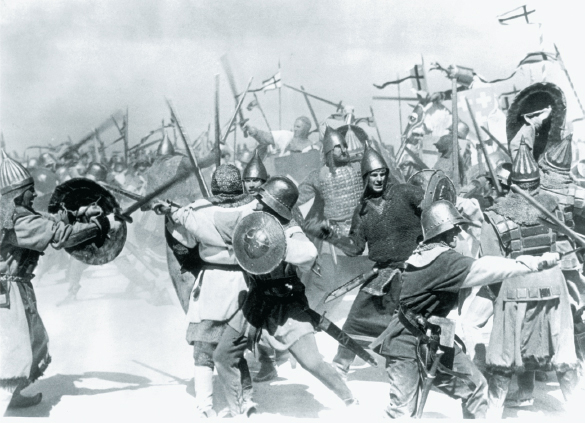Sergei Prokofiev, Alexander Nevsky Cantata (1938)

Sergei Eisenstein’s Alexander Nevsky ranks among the most monumental and innovative of early sound films. It is also propaganda. The title names a Russian hero from the thirteenth century who, having already defeated marauding Vikings, was called upon to unite Russian forces against invading Germans. The film was produced at a moment when tensions between Germany and the Soviet Union were on the rise. In case its allegory was not clear, the last words of the film are Nevsky’s proclamation, “He who comes to Russia with a sword, shall die by the sword.”
A year after Alexander Nevsky was made, Prokofiev refashioned his soundtrack music as a cantata so that it could be performed in concert. Our excerpts (which stay especially close to the original soundtrack) come from the beginning of the climactic scene in the film, when the Russians and the Germans meet in battle on the frozen surface of Lake Chudskoe. The reenactment is the most astonishing battle scene anywhere in early cinema. At its end the Germans, fleeing in disarray, crash through the ice and perish, to harrowing music for percussion only — which Prokofiev omitted, however, from his cantata.
From the music we get a series of vivid sound-
The mood is broken by a battle call in the distance — the signal for the Germans to advance; Prokofiev specifies a muted trombone, played backstage. The last six notes of this call will be heard again and again in the brass, sometimes in long note values and sometimes in quicker ones, as the Germans move forward. The energy picks up with the introduction of steady eighth notes in the strings and percussion, while the brass — tuba and horns, later trumpets and trombones also — present the call motive and alternate it with another, ominous chromatic motive.
Gradually the dynamics swell and the texture grows. A chorus is heard singing over and over a homophonic phrase; it is the Germans, intoning a liturgical hymn associated with their cruelty earlier in the film. At the climax, finally, the armies meet. Prokofiev’s music abruptly breaks off, and only the noise of battle is heard.
After more than three minutes of cinematic sword-